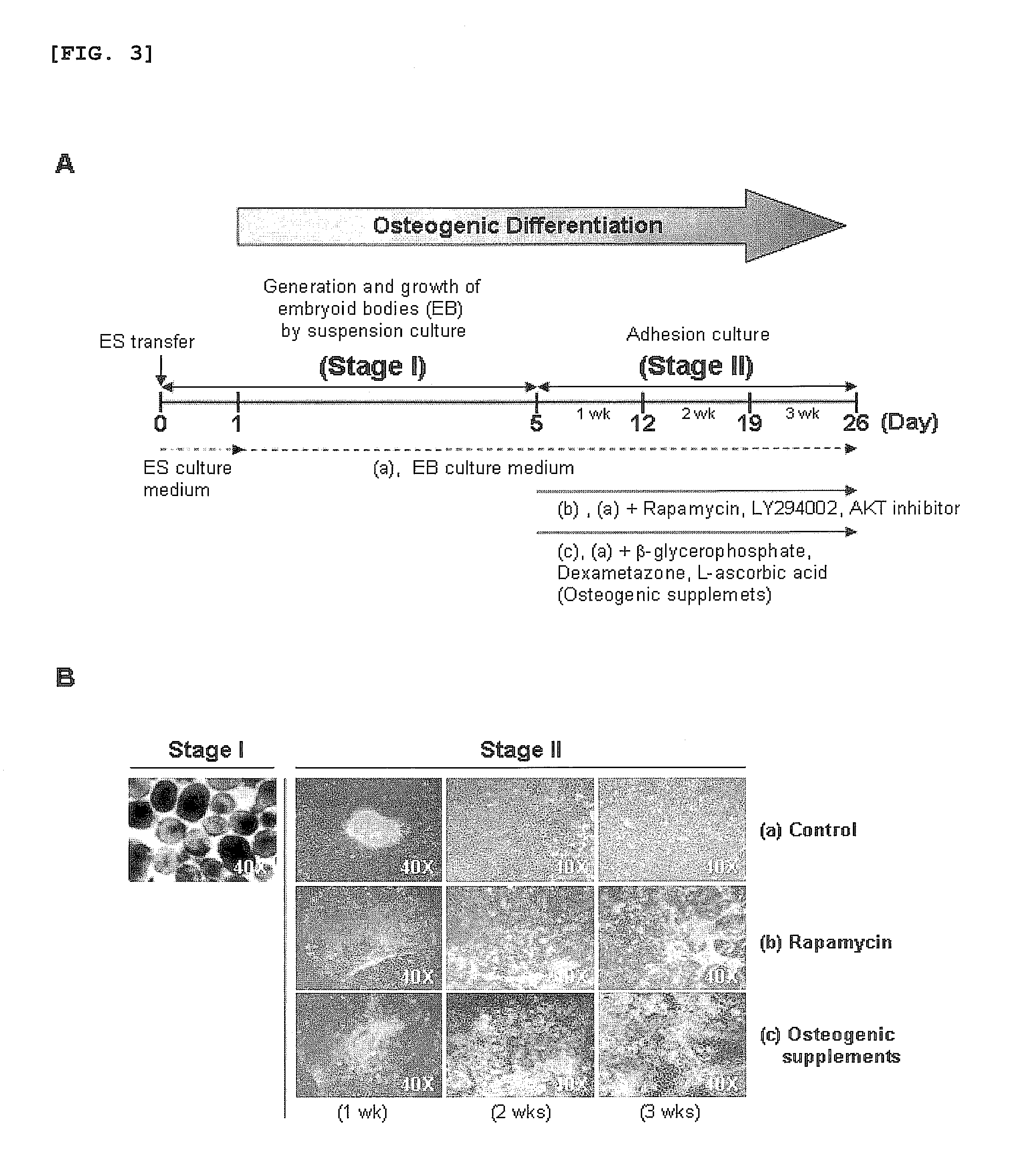mTOR inhibtors and mTOR signaling pathway inhibitors induce differentiation of human embryonic stem cells into the osteoblastic lineage
a technology of mtor inhibtors and signaling pathway inhibitors, which is applied in the field of mtor inhibtors and mtor signaling pathway inhibitors to induce differentiation of human embryonic stem cells into the osteoblastic lineage, can solve the problems of limited cell division cycle, small number, and inability to collect by bone marrow aspiration, and achieves the effect of improving stem cell function
- Summary
- Abstract
- Description
- Claims
- Application Information
AI Technical Summary
Benefits of technology
Problems solved by technology
Method used
Image
Examples
example 2
Preparation of Embryoid Bodies and Single Cells from Human Embryonic Stem Cells
[0038]In order to prepare consistent sizes of embryoid bodies, human embryonic stem cell colonies were sliced into cell clumps having dimensions of about 500×500 μm using a tool made from a glass pipette, and a suspension of the cell clumps was collected and transferred into bacterial culture dishes. The resulting embryoid bodies were dissociated into single cells by washing with phosphate buffered saline (PBS), adding a 1× trypsin-EDTA solution (TrypLE Express, Invitrogen), incubating at 37° C. for 1˜5 min, washing twice with PBS, and plating on Matrigel (BD biosciences, USA)-coated culture dishes.
example 3
Differentiation of Human Embryonic Stem Cells and Embryoid Bodies into Osteoblasts
[0039]For osteogenic differentiation by adhesion culturing, the human embryonic stem cells obtained in Example 1, after passage, were cultured in the culture medium of Example 1 for 2 days, and then in a culture medium, free of recombinant human FGF basic, containing 0.1˜200 nM rapamycin, 0.01˜50 μM LY294002, 0.01˜20 μM AKT inhibitor, or conventional osteogenic supplements (10 mM β-glycerophosphate, 0.1 mM Dexamethasone, 0.1 mM L-ascorbic acid) for 7 days, with daily replacement with a fresh embryonic stem cell culture medium (FIG. 2A).
[0040]For osteogenic differentiation by embryoid body formation, as shown in FIG. 3A, the human embryonic stem cells obtained in Example 1 were first cultured in the stem cell culture medium of Example 1 for one day after passage, and the stem cell colony was sliced into cell clumps having dimensions of 500×500 μm. After being collected as a suspension, the cell clumps w...
example 4
Detection of Osteoblastic Marker
[0042] Reverse Transcriptase PCR (RT-PCR) and Quantitative Real-Time PCR
[0043]The differentiation of human embryonic stem cells into osteoblasts in Example 3 was examined by detecting the expression of osteoblast-specific genes through RT-PCR and quantitative real-time PCR. For this, after treatment or non-treatment with rapamycin, LY294002, an AKT inhibitor or osteogenic supplements (10 mM β-glycerophosphate, 0.1 mM Dexamethasone, and 0.1 mM L-ascorbic acid), cells were collected according to differentiation stages and subjected to total RNA isolation using a TRIzol reagent (Invitrogen, USA). The RNA was used as a template to synthesize cDNA with a oligo(dT) primer in the presence of a Superscript II reverse transcriptase, followed by PCR with various primers listed in Table 1, below.
[0044]
TABLE 1AccessionProductGenesNos.SequencesSize (bp)GAPDHNM_002046ForwardGAAGGTGAAGGTCGGAGTC226ReverseGAAGATGGTGATGGGATTTCOct4NM_002701ForwardGAAGGATGTGGTCCGAGTGT243...
PUM
| Property | Measurement | Unit |
|---|---|---|
| size | aaaaa | aaaaa |
| density | aaaaa | aaaaa |
| sizes | aaaaa | aaaaa |
Abstract
Description
Claims
Application Information
 Login to View More
Login to View More - R&D
- Intellectual Property
- Life Sciences
- Materials
- Tech Scout
- Unparalleled Data Quality
- Higher Quality Content
- 60% Fewer Hallucinations
Browse by: Latest US Patents, China's latest patents, Technical Efficacy Thesaurus, Application Domain, Technology Topic, Popular Technical Reports.
© 2025 PatSnap. All rights reserved.Legal|Privacy policy|Modern Slavery Act Transparency Statement|Sitemap|About US| Contact US: help@patsnap.com



